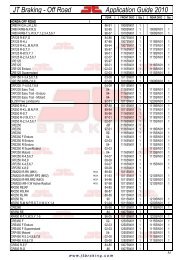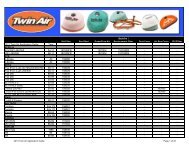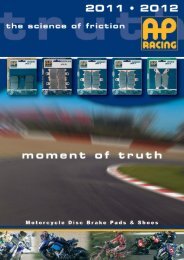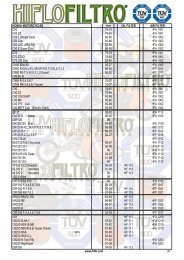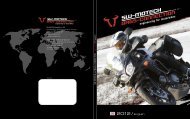DID 60 standard roller chain - Big Bike Webshop
DID 60 standard roller chain - Big Bike Webshop
DID 60 standard roller chain - Big Bike Webshop
Create successful ePaper yourself
Turn your PDF publications into a flip-book with our unique Google optimized e-Paper software.
For Use at High-temperature<br />
Chains strength is diminished by hightemperature<br />
atmosphere, direct conveying<br />
of high-temperature loads, or radiated heat,<br />
etc. The service limit at high-temperature<br />
depends not on the temperature of the<br />
service environment but the temperature and material of<br />
the <strong>chain</strong> body.<br />
Following conditions may occur when <strong>chain</strong>s are used<br />
at high-temperature:<br />
1) High temperature brittleness and fracture by lowered<br />
hardness of heat treated material<br />
2) Brittleness caused by carbide precipitation<br />
3) Abnormal wear by scale<br />
4) Fatigue fracture caused by repeated thermal shock<br />
(cooling and expansion)<br />
5) Abnormal wear due to an increase in the coefficient of<br />
friction<br />
6) Creep fracture<br />
7) Fracture due to thermal fatigue of welded area<br />
8) Effects caused by thermal expansion<br />
¡Stiff links and rotation failure due to decreased clearance<br />
¡Fatigue fracture due to lowered fitting force<br />
9) Lubrication failure and stiff links due to deterioration<br />
and carbonization of lubricating oil<br />
Grease excellent in heat resistance include those<br />
based on silicon, graphite or molybdenum disulfide.<br />
For use at high-temperature, high-temperature resistance<br />
bearings and stainless steel bearings are recommended.<br />
For Use at Low-temperature<br />
When using conveyor <strong>chain</strong>s at lowtemperature<br />
such as in a refrigerator or in a<br />
cold atmosphere, the following conditions<br />
may occur.<br />
1) Low temperature brittleness<br />
In general, a material is embrittled at low-temperature<br />
and shock resistance is lowered. This phenomenon is<br />
called low-temperature brittleness, and the degree of<br />
embrittlement differs from material to material.<br />
The service limit of a conveyor <strong>chain</strong> depends on its<br />
specifications.<br />
Variations in material and heat treatment Service limit temperature<br />
Standard<br />
J,A<br />
Wear resistance P,C,D -20°C<br />
With stainless steel parts D1,D3,D5<br />
Heavy-duty K,E -40°C<br />
Stainless steel<br />
S4,S5,SH<br />
Stainless steel S3 -100°C<br />
2) Influence of freezing<br />
At low-temperature, bending failure, <strong>roller</strong> rotation failure,<br />
fixing of <strong>chain</strong>, etc. may be caused by the freezing of<br />
penetrated water or deposited frost in the clearance between<br />
pins and bushings, bushings and <strong>roller</strong>s or inner plates and<br />
outer plates. These conditions cause an overload to act on<br />
the <strong>chain</strong> and drive, diminishing the life of the <strong>chain</strong>.<br />
To prevent freezing, in general, it is recommended to fill<br />
the clearances with a low-temperature lubricant suitable<br />
to the service temperature to prevent water, frost, etc.<br />
from penetrating the respective portions of the <strong>chain</strong>.<br />
For lubrication, a silicon based grease is recommended.<br />
For Use in Dusty Environment<br />
When using <strong>chain</strong>s in an environment of<br />
dirt, sand, dust, etc., periodically wash and<br />
lubricate the <strong>chain</strong>. For greasing, use a<br />
grease gun to allow the lubricant to<br />
sufficiently penetrate into the clearances<br />
between pins and bushings, bushings and <strong>roller</strong>s, and<br />
outer plates and inner plates. When using <strong>chain</strong>s in a<br />
highly abrasive environment, we recommend the following:<br />
1) Select a conveyor designed to prevent the <strong>chain</strong>s from<br />
coming into contact with the abrasive loads, or cover<br />
the <strong>chain</strong>.<br />
2) Select a <strong>chain</strong> with the largest size possible to reduce<br />
the face pressure of bearing portions such as between<br />
pins and bushings.<br />
3) Keep the <strong>chain</strong> speed as low as possible.<br />
4) Make grease holes in the pins and bushings, and<br />
lubricate with grease nipples.<br />
(Consult us when drilling pins and bushings as they are<br />
reinforced parts.)<br />
For dusty environments and highly abrasive environments,<br />
high wear resistant bearings such as <strong>chain</strong>, DJ, Diesten<br />
and Dimec bearings are available.<br />
For Use in Circumstances Exposed to Water or Sea Water Drops<br />
When <strong>chain</strong>s are exposed to rainwater or<br />
sea water drops, lowering of strength and<br />
brittleness by corrosion, sudden wear,<br />
bending failure by rusting and <strong>roller</strong> rotation<br />
failure etc. occur. In such cases, depending<br />
on the situation, stainless steel or high guard <strong>chain</strong>s or<br />
<strong>chain</strong>s with stainless steel parts are recommended. The<br />
high guard <strong>chain</strong>s are highly rated by our customers. For<br />
using <strong>chain</strong>s under water, see the following "For In-water<br />
Use".<br />
For In-water Use<br />
When using <strong>chain</strong>s in water or sea water,<br />
brittle fracture and corrosion must be taken<br />
into consideration in addition to the adverse<br />
conditions stated in the above section. For<br />
this purpose, we manufacture Water<br />
Treatment Conveyor Chains including Traveling Water<br />
Screen Transfer Chain, Rake Chain, Sewage Treatment<br />
Chain, BT Bushing Chain for Water Treatment Drive Unit.<br />
Chains with stainless steel parts, with specially coated<br />
plates or stainless steel <strong>chain</strong>s are recommended.<br />
Furthermore, as corrosion resistant bearings which can be<br />
used in-water, stainless steel, Diesten and Diemec<br />
bearings are available.<br />
Technical Data<br />
Chain Selection<br />
331



